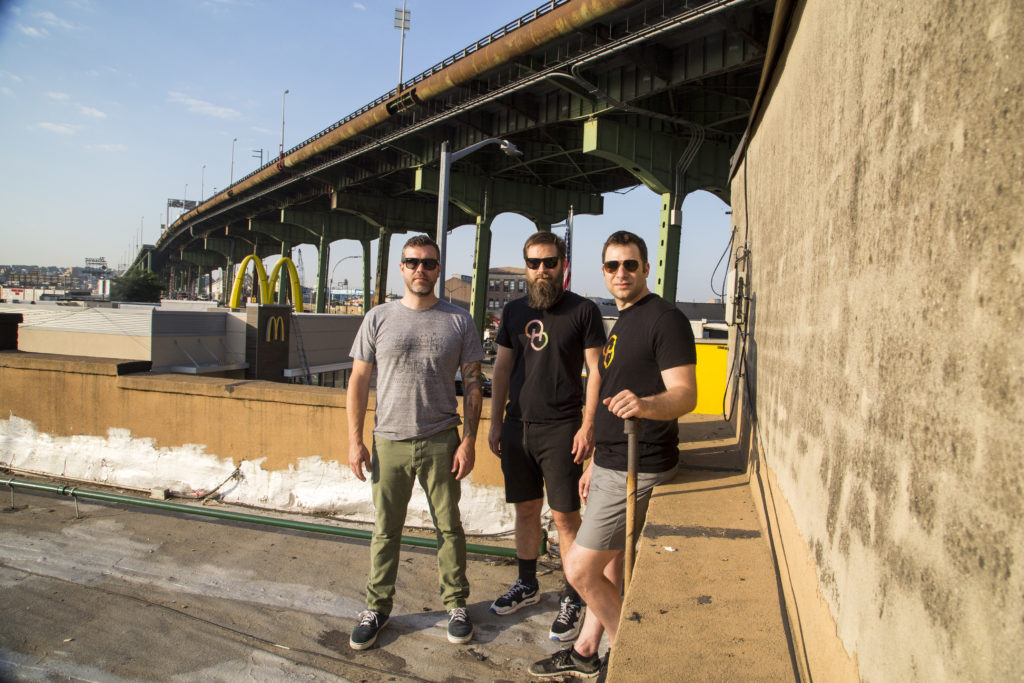The rumor was false at first, but it wound up coming true. Every few weeks the partners who own Brooklyn’s Other Half Brewing Co. head upstate, where they sell beer by the can to their thirsty fan base in the region. Quite a lot of beer. During a “mobile can sale” in March in Rochester, 400 people lined up starting at 5 a.m., lured by fresh batches of India Pale Ale (IPA), according to local reports. The brewers were sold out of 400 cases by noon.
Naturally, people who stand in line get to talking. “There was a rumor going around that we were buying a brewery,” Andrew Burman, Other Half’s director of operations, told The Bridge. “We actually weren’t looking for anything.” But then the partners started talking about it too, deciding “maybe we should look into this,” says Burman. Their eventual verdict: “Oh, this is a good idea.”
Last week, Empire State Development (ESD) announced that Other Half has bought a nearly-new brewery in East Bloomfield, about a half-hour drive southeast of Rochester in the Finger Lakes region. The ESD, the state’s economic-development agency, said it had offered up to $400,000 in tax credits to support the purchase. The reaction upstate, which already has plenty of its own breweries, was jubilant. “We are thrilled,” said town supervisor Frederick Wille. “This is a very big deal for us.”
The brewery’s tap room draws between 1,500 to 2,000 customers a week (Photo courtesy of Other Half)
Among craft brewers, Other Half is a celebrity. “Look at their track record,” says Jason Purdy, owner of the Now & Later Shop in Syracuse, where Other Half’s beers have been a hit. “They’re smart guys that have been successful at everything they do and the way they do it. Everything they’ve done has been really well planned out,” he told NewYorkUpstate.com.
Asked whether the acquisition was part of a grand expansion strategy, Burman laughs. “I wish we thought that far ahead,” he says. “It fell in our laps a little bit.”
The Nedloh Brewing Co., which had been built in 2014 by a couple named Holden (hence the brewery name, spelled backwards), had been dormant since last October, when the owners abruptly announced themselves done with the brewing business. “When we visited it, we really liked it,” says Burman. “It looked like one day, they just stopped brewing.”
Other Half paid $660,000 for the 5,000-sq.-ft. brewery and plans to invest another $1.8 million to make a few alterations and expand production. They expect to hire 20 to 25 employees right away and up to 35 over the next few years.
Other Half showed its Instagram followers a sneak preview of the new brewery
Feeling expansive, the partners are buying four acres of land behind the brewery and hope to buy more soon. While their Brooklyn brewery is gritty and cramped, they aim to pursue a more rustic approach upstate. “We would love to make more saison and wild beers that use all local ingredients and have local yeast as well. We want both properties to be Other Half, but to have their own identity,” says Burman.
Launched just four years ago on an anonymous warehouse block at the south end of Carroll Gardens, Other Half quickly developed a cult following. Specializing in hazy, hoppy New England-style IPAs, promoted with inventive graphics on the cans and infectious social media, the brewery started drawing hundreds of craft-beer devotees to its weekly, limited-edition can sales. The lines became legendary. With the beer typically priced at $5 a can, it’s a good business.
Jesse Sayre hauled away his beer purchase after waiting in line for nearly eight hours one Saturday at Other Half (Photo by Steve Koepp)
Other Half currently produces about 8,000 to 10,000 barrels a year, brewing around the clock, and hopes to boost output by another 5,000 to 6,000, says Burman. “We’re doing what we can in Brooklyn, trying to just not run out of anything and make sure you don’t have to get up at 5 in the morning to get cans.” Some of the increased output will be keg beer for bars and restaurants, which currently get very little distribution, given the brewery’s direct-to-consumer demand.
Ironically, Other Half’s rapid growth comes at a time of declining sales for the major brewers. “As sales slide, a sense of crisis has taken hold of the industry,” the Wall Street Journal reported today. Many beer drinkers, especially younger ones, have turned to wine and cocktails instead. The company that owns Budweiser found that in 2016, just 43% of alcohol consumed by young drinkers was beer, down from 65% a decade earlier. Of food-and-beverage brands in general, the Journal concluded, “Consumers, especially younger ones, are gravitating toward smaller brands marketed as healthier, more natural or made closer to home.”
That trend has fueled the proliferation of craft breweries–Brooklyn has gone from zero to 20 in a generation–but even the craft industry’s double-digit growth has slowed down with so many entrants. That doesn’t faze Other Half. “I 100% agree, it is crowded,” says Burman. “But there’s not enough great breweries around. The crowdedness comes from the bigger guys coming in and forcing their will upon people. There’s plenty of room for great breweries.”
Exclusive: we’ve compiled a list of brewers in Brooklyn’s booming craft-beer industry, ranking the borough’s 20 brewers by their social-media following, which has become the primary way for fans to discover new products. (For capsule profiles of more than a dozen newcomers, see our story on Threes Brewing, as well as our profiles of Sixpoint and Other Half breweries.) If you see any errors or omissions on our list, please let us know at editor@thebridgebk.com and we’ll make a prompt update.
